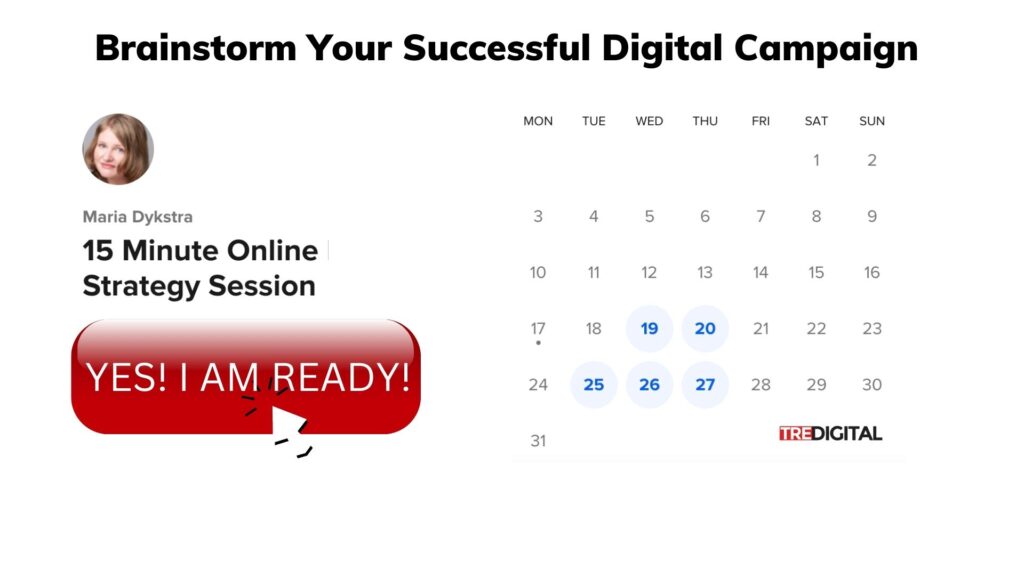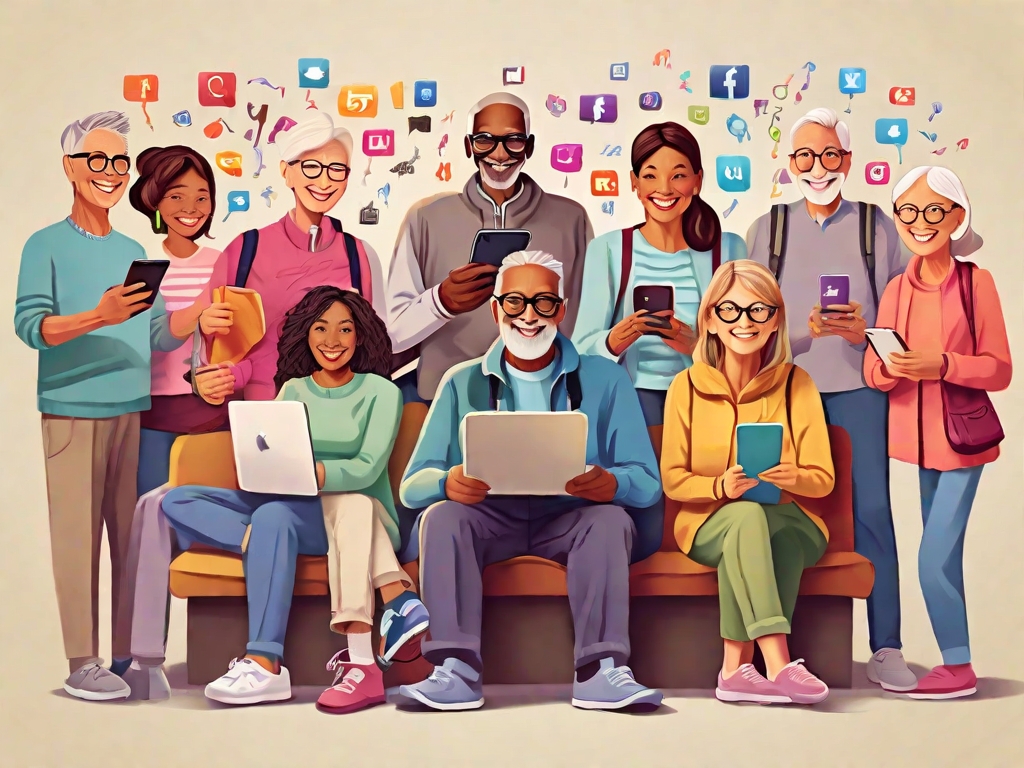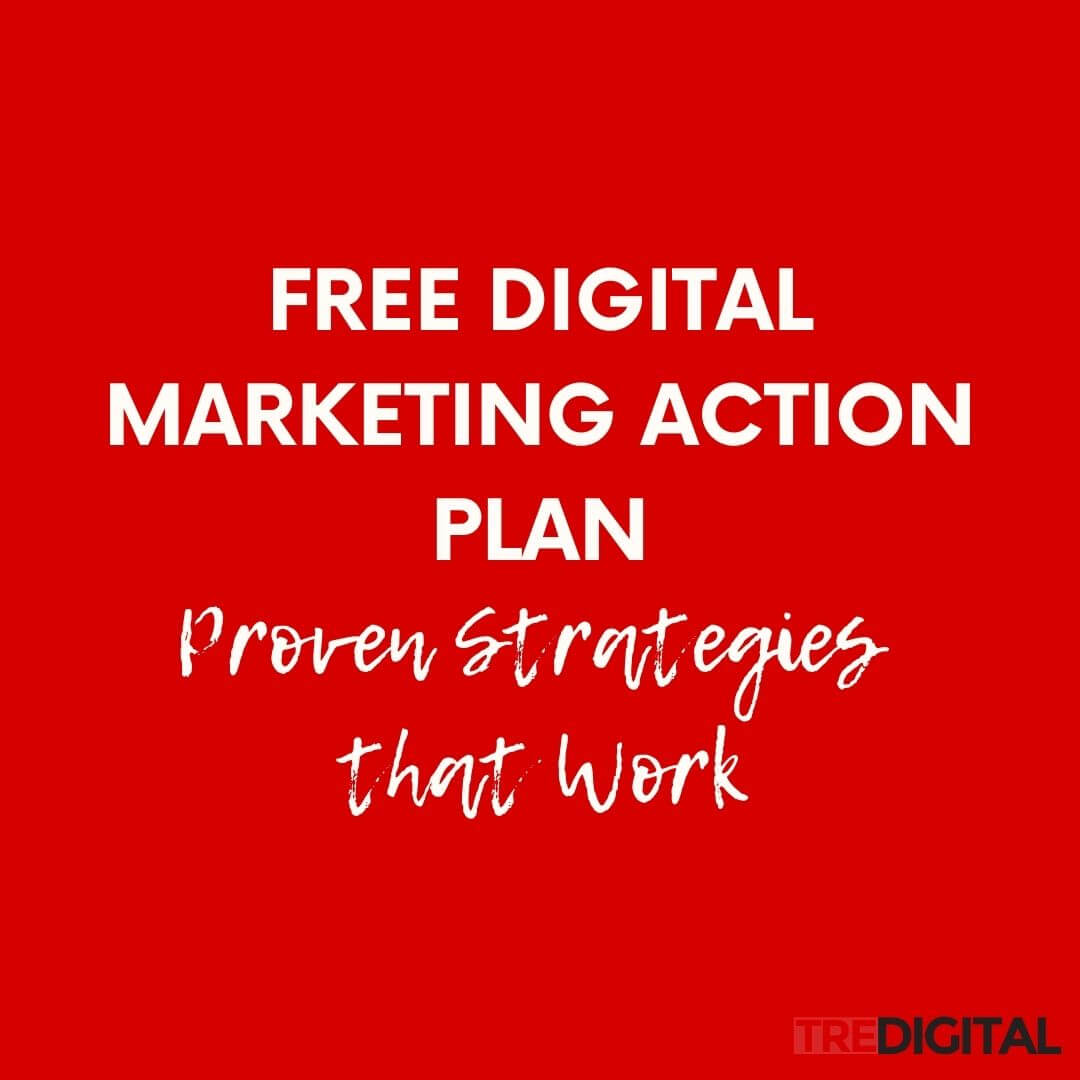In today’s increasingly diverse and digital world, it’s more important than ever for marketers to understand the unique needs and preferences of each generation. Unfortunately, many marketers fail to do so, and their campaigns fall flat.
One of the biggest mistakes marketers make is assuming that all consumers are the same. This is simply not the case. Different generations have different values, interests, and communication styles. What resonates with one generation may not resonate with another.
That’s why it’s so important to tailor your marketing campaigns to each generation. By doing so, you can bridge the gap between your brand and your target audience, and build relationships that lead to long-term success.
Table of Contents
ToggleWhat is the generational marketing strategy?
Generational marketing is a marketing strategy that targets different generations of consumers based on their unique characteristics and preferences. It is based on the idea that different generations have different values, lifestyles, and spending habits. By understanding these differences, marketers can create more effective campaigns that resonate with their target audience.
There are four main generations that marketers typically target:
- Baby Boomers (born 1946-1964)
- Generation X (born 1965-1980)
- Millennials (born 1981-1996)
- Generation Z (born 1997-present)
Each generation has its own unique set of characteristics and preferences. For example, Baby Boomers are often more traditional and value quality over price. Generation X is more self-reliant and values authenticity. Millennials are more socially conscious and value experiences over possessions. Generation Z is more digital-savvy and values diversity and inclusion.
When developing a generational marketing strategy, it is important to consider the following factors:
- Target audience: Who are you trying to reach? What generation are they from?
- Messaging: What kind of messaging will resonate with your target audience?
- Channels: Where does your target audience spend their time?
- Content: What kind of content will your target audience find engaging?
What are some of the examples of generational marketing?
Duolingo is a great example of generational marketing. The language learning app has a strong presence on TikTok, a social media platform that is popular with Gen Z. Duolingo’s TikTok videos are engaging and informative, and they often feature Gen Z influencers. This helps Duolingo to connect with its target audience and build brand awareness.
Here are some other examples of generational marketing:
- Apple: Apple’s marketing campaigns often target Millennials and Gen Z. The company uses social media channels like Instagram and TikTok to reach these audiences. Apple’s ads also focus on the values that are important to Millennials and Gen Z, such as creativity, innovation, and sustainability.
- Dove: Dove’s “Real Beauty” campaign is a great example of generational marketing that targets women of all ages. The campaign celebrates diversity and inclusion, which are values that are important to Millennials and Gen Z.
- Nike: Nike’s “Just Do It” campaign is another example of generational marketing that targets Millennials and Gen Z. The campaign encourages people to pursue their dreams and to be themselves. This messaging resonates with Millennials and Gen Z, who are often looking for brands that align with their values.
By understanding the needs and preferences of each generation, and by choosing the right channels, messaging, and content, you can create multi-generational marketing campaigns that resonate with everyone.
Bridge the Gap: How to Successfully Market To Different Generations
In this blog post, we’ll explore the key strategies for successfully marketing to different generations. We’ll cover everything from understanding their needs and values to choosing the right channels and messaging. By the end of this post, you’ll have the tools you need to create marketing campaigns that resonate with every generation.
Here’s a sneak peek at what we’ll cover:
- Understanding the different generations: What are their values, interests, and communication styles?
- Choosing the right channels: Where do they spend their time online and offline?
- Crafting compelling messaging: What kind of messaging will resonate with each generation?
- Creating engaging content: What kind of content do they want to see and share?
So stay tuned! In the next section, we’ll start by exploring the different generations and their key characteristics.
Baby Boomers: Everything You Need to Know to Reach This Unique Generation
Baby Boomers: They’re not your grandparents. In fact, they’re a demographic worth their weight in gold when it comes to marketing. Did you know that Baby Boomers control over 70% of disposable income in the US? That’s no small change!
Let’s dive into this generational treasure chest with a little humor, a dash of storytelling, and insights that’ll have you rethinking your approach.
The Baby Boomer Story:
Imagine you’re a Baby Boomer, not your typical grandparent figure, right? You’ve seen the world change from rotary phones to smartphones, from vinyl records to streaming services. Your preferences have evolved, but some things remain constant. Family, tradition, and security are values you hold dear.
Baby Boomers spend their time online and offline in a variety of ways. Here are a few of the channels where you can reach them:
- Traditional media: Baby Boomers still consume a lot of traditional media, such as TV, radio, and print.
- Email: Baby Boomers also rely on email for communication and shopping.
- Social media: Baby Boomers are increasingly active on social media, but they prefer platforms like Facebook and YouTube over newer platforms like TikTok and Snapchat.
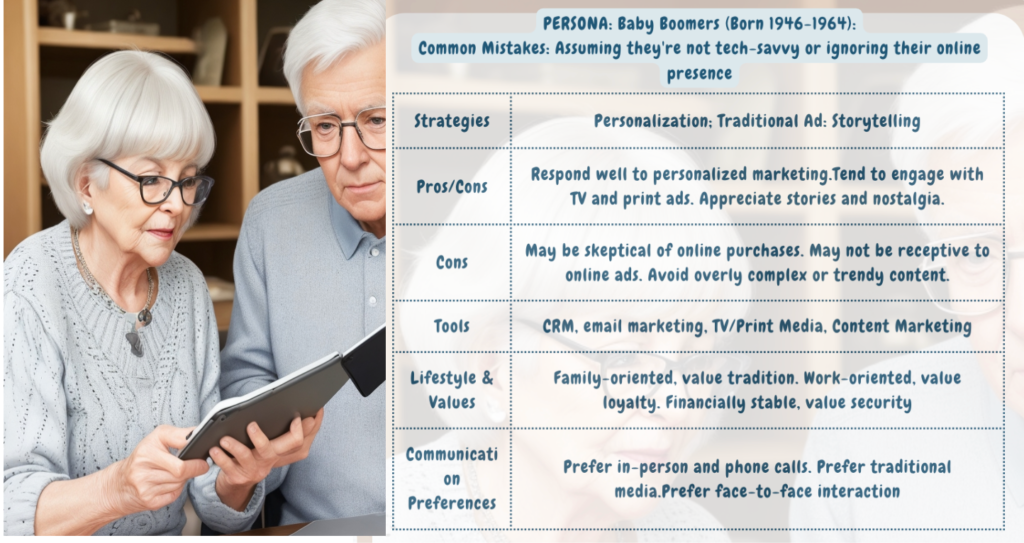
Marketing Strategies for Baby Boomers:
- Personalization: Imagine receiving an email that speaks directly to your interests, not just a generic message. Baby Boomers appreciate this personal touch. So, don’t shy away from using CRM tools and email marketing to make them feel valued.
- Traditional Ads: You’re watching TV, and a nostalgic ad comes on, tugging at your heartstrings. You engage with it, and it sticks in your memory. That’s the power of traditional advertising for Baby Boomers. Go for TV and print media to connect with them effectively.
- Storytelling: Imagine reading a blog post that shares a relatable story from the past, evoking warm memories. Baby Boomers love storytelling that resonates with their experiences. Share stories and keep content simple and relatable.
Dove’s Pro-Age campaign is a great example of a campaign that worked for Baby Boomers: This campaign celebrated aging and featured real women discussing their experiences of aging. It resonated with Baby Boomers who appreciated seeing positive and realistic representations of their generation.
Communication Preferences:
Now, think about your communication style. As a Baby Boomer, you prefer the personal touch. In-person and phone calls resonate with you. Remember this when developing your customer service and communication channels.
Here are a few tips for creating engaging content for Baby Boomers:
- Focus on quality over quantity.
- Write in a clear and concise style but also use humor.
- Use images and videos to break up your text and make it more visually appealing.
- Promote your content on social media and other channels where Baby Boomers spend their time.
So, if you’re looking to tap into that 70% of disposable income controlled by Baby Boomers, humor them, tell stories they relate to, and embrace their values. They’re not your grandparents; they’re a generation worth engaging with in your marketing efforts.
Gen X Marketing: How to Market to the Generation That Controls the Most Spending Power
Generation X: They’re not your parents, and they’re not your kids. They’re the independent, pragmatic generation born between 1965 and 1980. Did you know that Generation X controls over 50% of discretionary spending in the US? That’s a significant market share you don’t want to overlook!
Let’s step into the world of a Gen Xer and explore marketing strategies that truly connect with this generation.
The Gen X Story:
Imagine you’re a Gen Xer. You’ve witnessed the evolution from cassette tapes to streaming services, from clunky cell phones to sleek smartphones. You’re known for your practicality, independence, and strong work ethic.
Gen Xers spend their time online and offline in a variety of ways. Here are a few of the channels where you can reach them:
- Social media: Gen Xers are active on social media, but they prefer platforms like Facebook, Twitter, and LinkedIn over newer platforms like TikTok and Snapchat.
- Email: Gen Xers still rely on email for communication and shopping.
- TV: Gen Xers still watch TV, but they’re also cord-cutting and streaming more often.
- Radio: Gen Xers still listen to the radio, especially in their cars.
- Print: Gen Xers still read newspapers and magazines, especially local and business publications.
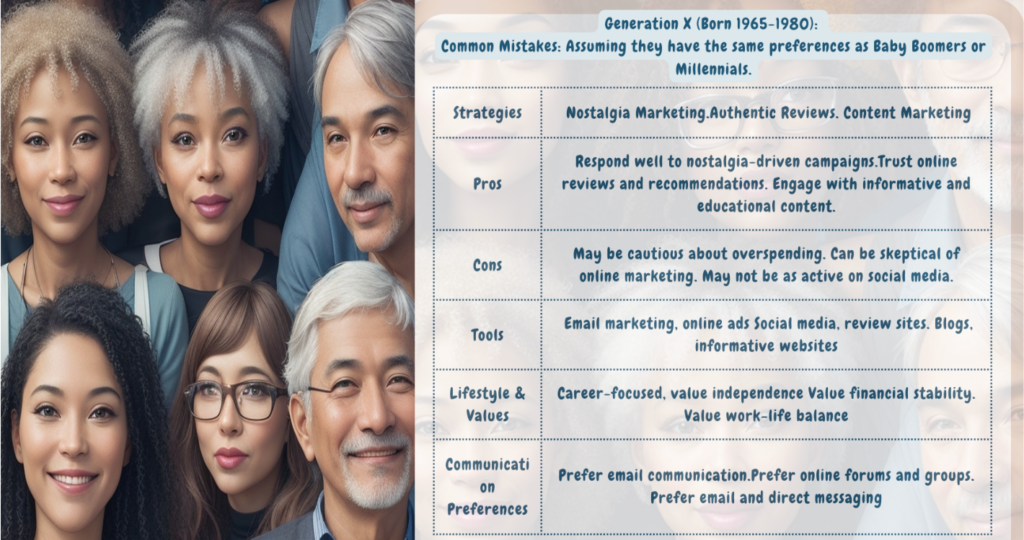
Marketing Strategies for Generation X:
- Nostalgia Marketing: Gen Xers respond well to nostalgia-driven campaigns that take them back to their youth. Use email marketing and online ads to trigger fond memories, but keep your offers budget-friendly to match their practical mindset. They may be cautious about overspending, so ensure your promotions align with their financial sensibilities.
- Authentic Reviews: Gen X values trust and authenticity. They rely on online reviews and recommendations to make informed choices. Build trust on social media and review sites with genuine, reliable content. They can spot a fake from a mile away, so maintain the integrity of your online presence.
- Content Marketing: Gen X engages with informative and educational content. They appreciate blogs, informative websites, and the value of work-life balance. They may not be as active on social media, so focus on email and direct messaging for communication. Create blogs and informative websites for sharing valuable information. Use email and direct messaging for personalized, informative interactions.
Apple’s “Think Different” campaign: This campaign resonated with Gen Xers because it celebrated individuality and non-conformity. It encouraged Gen Xers to think differently and to be true to themselves.
Communication Preferences:
When communicating with Generation X, remember that they prefer email communication and direct messaging. These methods align with their independent and practical nature.
Here are a few tips for creating engaging content for Gen X:
- Focus on quality over quantity.
- Write in a clear and concise style.
- Use images and videos to break up your text and make it more visually appealing.
- Promote your content on social media and other channels where Gen Xers spend their time.
So, in the world of Generation X, avoid the clichés. Customize your marketing strategies to appeal to their appreciation of nostalgia, authenticity, and informative content. By understanding their unique values and communication preferences, you can create marketing campaigns that truly resonate with this influential and often underestimated generation.
Millennials: How to Reach and Persuade This Powerful Demographic
They are not as easy to fool as you think.
Millennials: Born 1981 – 1996 they are the generation that knows what they want, and they are not afraid to ask for it. So don’t try to sell them any BS.
Did you know that Millennials have a shorter attention span than goldfish? That’s right, they are scrolling through our phones and swiping left and right faster than a goldfish can swim. So you better make your marketing campaigns count.
Now, imagine you’re a Millennial. You’re scrolling through social media, and you see an ad. You immediately know it’s fake, and you start to laugh. What kind of marketing messages would actually resonate with you?
The Millennial Story:
Picture yourself as a Millennial. You grew up in a world that shifted from dial-up internet to high-speed Wi-Fi, from brick-sized cell phones to pocket-sized supercomputers. You value authenticity, experiences, and social responsibility. But you’re also wary of marketing tricks.
Millennials spend their time online on these channels:
- Social media: Millennials are active on a variety of social media platforms, including Instagram, TikTok, Snapchat, and YouTube.
- Streaming services: Millennials prefer to stream movies and TV shows online rather than watch traditional cable or satellite TV.
- Messaging apps: Millennials use messaging apps like WhatsApp and Facebook Messenger to stay connected with friends and family.
- E-commerce: Millennials are avid online shoppers.
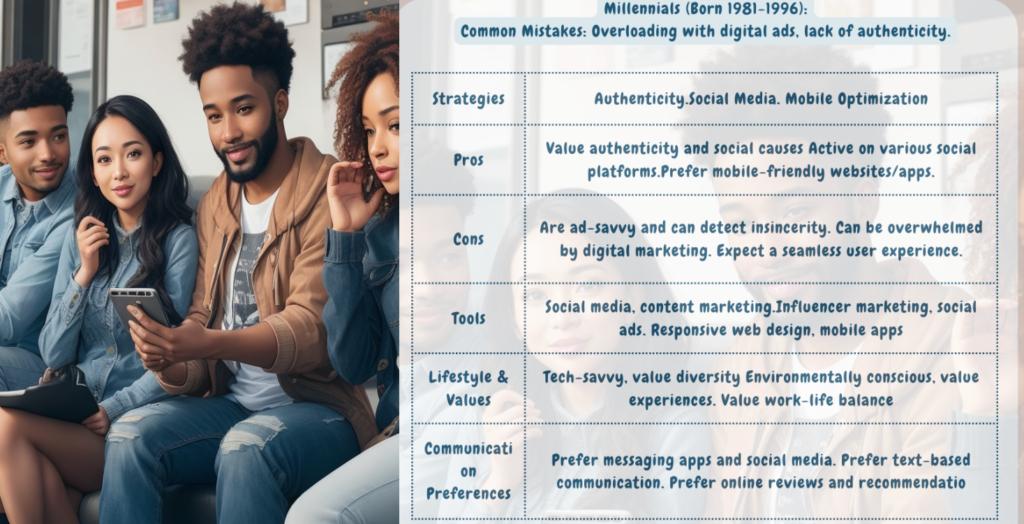
Why Marketing to Millennials is Difficult: Key Marketing Strategies for Millennials:
- Authenticity is Key: Millennials can spot insincerity from a mile away. They can be unforgiving if they sense you’re being inauthentic or trying to manipulate them. Be genuine, share your brand’s values, and support social causes that matter. Use social media to engage with your audience, showcase real stories, and build trust.
- Storytelling with Purpose: Millennials are drawn to meaningful narratives. If your storytelling lacks depth or purpose, Millennials won’t waste their time.Craft stories that resonate with their values and aspirations. Use video content to convey your message effectively, and create a narrative that captures their attention.
- Instant Gratification: Millennials value convenience and instant gratification. If your process is complicated or slow, you’ll lose their interest in seconds. Provide easy and fast solutions. Implement mobile-friendly marketing, efficient customer service, and streamlined online shopping.
Nike’s “Find Your Greatness” campaign inspired Millennials to pursue their passions and achieve their goals, and it resonated with Millennials who are ambitious and value self-improvement.
Communication Preferences:
When communicating with Millennials, remember that they prefer instant messaging and social media. Quick responses and easy access to information are vital.
Choosing the right channels for Millennials
Millennials spend their time online and offline in a variety of ways. Here are a few of the channels where you can reach them:
- Social media: Millennials are active on a variety of social media platforms, including Instagram, TikTok, Snapchat, and YouTube.
- Streaming services: Millennials prefer to stream movies and TV shows online rather than watch traditional cable or satellite TV.
- Messaging apps: Millennials use messaging apps like WhatsApp and Facebook Messenger to stay connected with friends and family.
- E-commerce: Millennials are avid online shoppers.
What attracts millennials to brands?
Millennials are value-driven consumers who appreciate authenticity and transparency. They want to know that the brands they support are aligned with their values and that they are getting a good value for their money.
Here are a few tips for crafting compelling messaging for Millennials:
- Focus on your brand’s values and how they align with the values of your target audience.
- Be transparent about your products or services and how they can benefit Millennials.
- Use authentic and relatable language.
- Avoid using too much jargon or technical terms.
- Use social proof, such as testimonials and customer reviews, to support your claims.
Creating engaging content for Millennials
Millennials are interested in a variety of content, including:
- Educational and informative content: Millennials are always looking to learn new things. They are interested in content that can help them improve their lives, careers, and relationships.
- Entertaining and humorous content: Millennials also enjoy content that is entertaining and humorous. They appreciate content that can make them laugh and smile.
- Behind-the-scenes content: Millennials are curious about what goes on behind the scenes at their favorite brands. They enjoy content that gives them a glimpse into the company culture and the people who work there.
So, if you’re aiming to connect with Millennials, ditch the clichés and tricks. Be authentic, tell meaningful stories, and offer instant gratification. By understanding their values and communication preferences, you can create marketing campaigns that truly resonate with this tech-savvy and socially conscious generation.
Generation Z: Unlock the Secrets of Gen Z Marketing
Gen Z: They aer the most sceptical generation yet. They are scrolling, swiping, and flipping through content faster than you can say “viral meme.” You better make your marketing campaigns quick and to the point.
Now, imagine you’re a Gen Z-er. You’re scrolling through TikTok and see an ad. You immediately know it’s cringe. So, what kind of marketing messages would actually resonate with them?
The Gen Z Story:
Visualize yourself as a Gen Z-er. You’ve grown up in a digital world, where memes, challenges, and viral content rule the internet. Authenticity, diversity, and social responsibility matter to you. You’re the generation that knows how to have fun online while staying socially aware.
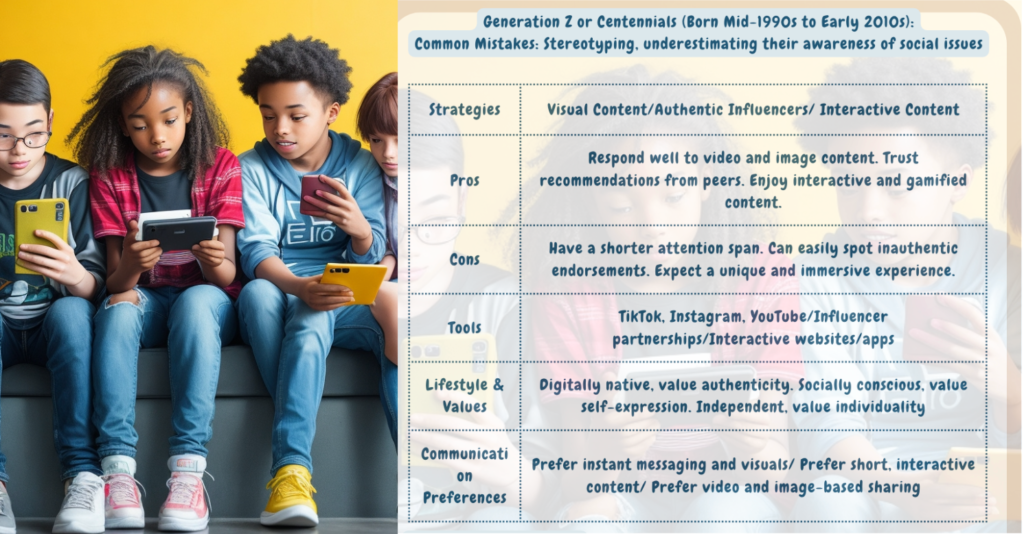
DOWNLOAD FREE TEMPLATE
Here are a few of the channels where you can reach them:
- Social media: Gen Z-ers are active on a variety of social media platforms, including TikTok, Instagram, YouTube, and Snapchat.
- Messaging apps: Gen Z-ers use messaging apps like WhatsApp, Discord, and iMessage to stay connected with friends and family.
- Streaming services: Gen Z-ers prefer to stream movies and TV shows online rather than watch traditional cable or satellite TV.
- Gaming platforms: Gen Z-ers are avid gamers, so you can reach them on gaming platforms like Twitch and Steam.
Marketing Strategies for Gen Z:
- Authenticity Rules: Gen Z can smell inauthenticity a mile away. Gen Z won’t hesitate to call out anything that seems disingenuous.Be real, share your values, and support causes that matter. Use social media platforms and collaborate with influencers who align with your brand’s authenticity. Collaborate with genuine influencers who share your brand’s values.
- Visual Appeal: Gen Z appreciates visually engaging content. Use eye-catching visuals and videos to grab their attention. Bland or boring visuals won’t make the cut. Engage in short-form video marketing on platforms like TikTok and Instagram Reels.
- Engagement and Participation: Passive and one-way communication won’t work with Gen Z. They want to be part of the action. Involve them, ask for their input, and make them part of your brand’s story. Create interactive and participatory campaigns and challenges that encourage user-generated content and involves your audience in your brand’s narrative
Adidas “Dream Big” campaign encourages Gen Z to pursue their dreams and to make a difference in the world. Adidas shifts the attention to lesser known football teams with the notion that anyone can dream big, no matter what their ranking.
Communication Preferences:
When communicating with Gen Z, keep in mind that they prefer instant messaging and social media platforms. Respond quickly, and be ready for conversations.
Here are a few tips for crafting compelling messaging for Gen Z:
- Focus on your brand’s social mission and how it is making a positive impact on the world.
- Be authentic and transparent in your messaging.
- Use diverse and inclusive language and imagery.
- Avoid using traditional marketing tactics, such as sales pitches and hard sells.
- Instead, focus on creating content that is informative, entertaining, and relevant to Gen Z-ers.
So, if you’re looking to connect with Gen Z, remember, we’re not fooled by traditional ads or gimmicks. Be authentic, visually appealing, and engage us in meaningful ways. By understanding our values and communication preferences, you can create marketing campaigns that genuinely resonate with this fast-paced, socially conscious, and fun-loving generation.
CONCLUSION
By understanding the needs and preferences of each generation, and by choosing the right channels, messaging, and content, you can create multi-generational marketing campaigns that resonate with everyone.
Here is a summary of the key takeaways from this blog post:
- Baby Boomers: Value personalization, traditional advertising, and storytelling. They prefer TV, radio, print, and email.
- Gen X: Respond well to nostalgia marketing, authentic reviews, and content marketing. They prefer social media, email, and direct messaging.
- Millennials: Appreciate authenticity, experiences, and social responsibility. They prefer social media, streaming services, messaging apps, and e-commerce.
- Gen Z: Value diversity, inclusion, and sustainability. They prefer social media platforms like TikTok and Instagram, and they are avid consumers of short-form video content.
By following these tips, you can create marketing campaigns that bridge the gap between your brand and your target audience, and build relationships that lead to long-term success.
